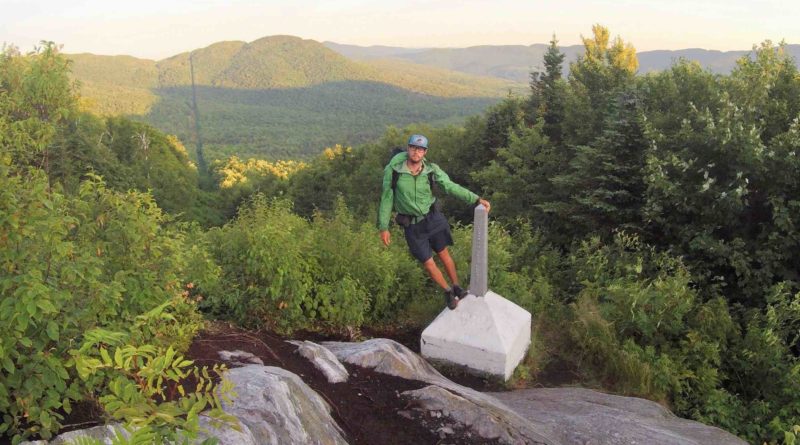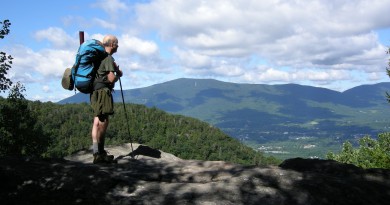How One Hiker Shattered the Long Trail FKT
When Jeff Garmire arrived at the sign marking the southern terminus of Vermont’s Long Trail on July 24, he was in tough shape. His ankles had nearly disappeared from swelling and his stomach was roaring with hunger. His mind, twisted with the effects of sleep deprivation, was beginning to play tricks on him: Leaves that covered the ground were childrens’ toys and a puddle reflecting blue sky was a hole in the earth that could send him spinning endlessly into space.
He felt no pain. But when he looked at his watch, he knew that he’d accomplished what he’d set out to do just five days earlier: He’d hiked unsupported the length of the oldest long-distance hiking trail in the country in five days, 23 hours, and 48 minutes.
It was not only a new record, it shattered the record of six days, nine hours, 48 minutes Josh Perry just set in June. The previous record set by Travis Wildeboer in 2010 was six days, 17 hours, 25 minutes.
Garmire, 28, is no stranger to the long haul. Growing up in Oregon, he regularly went out into the woods with his parents for weekend trips. He hiked his first thru-hike on the Pacific Crest Trail (PCT) in 2011.
“That got the ball rolling and ever since I’ve made it a point to do it as much as I can,” he said. In 2016, Garmire completed the Triple Crown, one of the toughest feats of thru-hiking.
To do so, he hiked the 2,653-mile- long PCT; the Appalachian Trail, 2,190 miles from Georgia to Maine; and the Continental Divide Trail, which runs 3,100 miles from Mexico to Canada along the Rocky Mountains—all within 12 months. In total, his year included about 8,000 miles of hiking.
In 2018, he hiked the Great Western Loop, a 6,875-mile loop through nine states that links five long-distance trails. Garmire, the second person to complete the loop, finished it in 208 days.
For 2019, Garmire set a goal to hike not for distance but for speed. In April, he set an unsupported speed record on the 800-mile-long Arizona Trail, breaking the previous record by three days to set a new record of 15 days, 13 hours and 10 minutes. “I wanted to see if I could stretch the comfort zone even further from the Arizona trail to the 272- mile Long Trail, which is known among ultrarunners,” he said. “It’s almost like a different sport.”
Garmire, who hikes under the trail name “Legend,” talked with Vermont Sports about his latest adventure in the Green Mountains, what it required of him and his plans for the future.
When did you get the idea to go for a FKT on the Long Trail and how did you go about preparing? I had an idea in December to try and do a few of these this year and the Long Trail was on the list. It was something I decided to do after I was successful on the Arizona Trail. Without that, I don’t know if I would’ve gone for it. I trained in California’s Sierra Nevada at about 10,000 feet for about three weeks. I did the John Muir trail and then added about 100 or so more miles. It was mostly hiking but I was running most days as well. I spent a lot of time listening to my body. If I didn’t feel like a big workout I would hike with my buddy, but if I wanted a big workout, I’d put the pack on and go for a run as well.
Let’s talk gear. What were you carrying on the Long Trail?
I did it unsupported, which meant I had all my food with me for six days but stopped for water. I had a lightweight Six Moons Designs tarp to use mostly as a groundsheet but that I could also set up in a rainstorm. I had a Katabatic quilt that was my sleeping bag, rain gear, two shirts and a couple of pairs of socks. I wore adidas trail running shoes because they’re supposed to be good on slippery ground, but the rocks in Vermont seem to be slippery no matter what kind of shoe you’re wearing. The pack is a custom pack by LiteAF that had enough external storage so I could grab everything I needed while moving. I tried to keep my gear as minimal as possible. I had my base weight down to about seven pounds before adding food and water. Since it was six days’ worth of food I had about 20 pounds of food. That went down quickly because the strategy was to eat two-thirds of the food in the first half of the trip so it would be much lighter for the final push.
What were some of the highs and lows you experienced?
I started out at the Canadian border and had a really good first day. I was able to pound out about 48 miles and just made myself go to sleep because I needed to get enough sleep for the next day and I felt like I could keep going. But I woke up on Day Two and my legs were cramping up as I put on my shoes. Days Two and Three were the crux of the route with a heavy pack and hikes over Mansfield, Madonna, and Camel’s Hump. Those are some of the hardest portions of the trail. That’s where I hit the lowest low and my expectations were a lot higher than the actual miles I was able to make those days. It felt like my amazing first day was being washed out by two sub-par days. It was really hard to mentally reconcile. Day Four was when the trail started to loosen up after Lincoln Gap and I was able to improve my mileage. I got this feeling of determination at around the end of the day and slept about three or four hours. Once Day Five started that’s when the big push began. At 5 a.m. on the morning of Day Five I had 108 miles left. I hiked through the night and the next day. Within 12 miles to the finish, my mind and body were messed up from lack of sleep, so I took a one-hour nap and that morning I finished the last of it. My goal was to get under six days, and I did it by 12 minutes. I guess that’s the power of setting goals.
How did you feel when you reached the southern terminus?
I’ve never had an emotion like the one I felt at the end of this hike. When I saw that I broke the six days mark by 12 minutes it was such a feeling of relief. I did what I thought I could do and was happy but mostly relieved. I felt like I was either at or just below my ability to break that six-day mark. I’m pretty proud that I was able to set and reach a goal that was at the edge of my limit and comfort zone. I had my last handful of peanuts with 12 miles to go and when I got to the road a friend was waiting with ten quesadillas and I ate them all. I would’ve eaten anything.
While the LT is the oldest trail, how does it stack up alongside the other trails you’ve hiked?
The northern 130 miles is the hardest true trail I’ve ever, ever hiked. I’ve done some cross country routes that are comparable to it but the fact that it’s a trail with blazes is just amazing. You’ve got ladders, and rebar and you’ve got to slide down areas on your butt. It’s amazing how rugged those 130 miles of the Long Trail are.
So what’s next?
In September I may do a couple of projects on the West Coast, maybe the John Muir or the Tahoe Rim trail. But my feet have disappeared because they’re so swollen. I need to rest before I think about anything else. My book comes out in a couple weeks so that’s the next big thing. It’s about my calendar year Triple Crown. The title is Free Outside and it’s about all the stories that go into a 252-day, 8,000-mile adventure, between getting attacked by a moose to swimming across a frozen river. All the stories I look back on and cringe at but I am happy that I have the ability to tell them now.
The hashtag you put up with all your Instagram posts is #doepicshit. What’s the story behind that?
I was running in a blizzard while living in Tahoe, training for the Arizona Trail and I just thought it was a funny double- edged sword. Everyone wants to do epic stuff, but most people think that doing an 800-mile hike or a 272-mile hike as fast as you can doesn’t sound that great. It’s shit to most people, but to me it’s epic. That’s how I frame it in my mind.
Featured Photo Caption: Jeff Garmire strikes a casual pose at the northern start of The Long Trail, before setting out to hike 272 miles in fewer than six days.
Photo courtesy Jeff Garmire



awesome story and feat